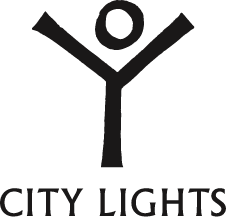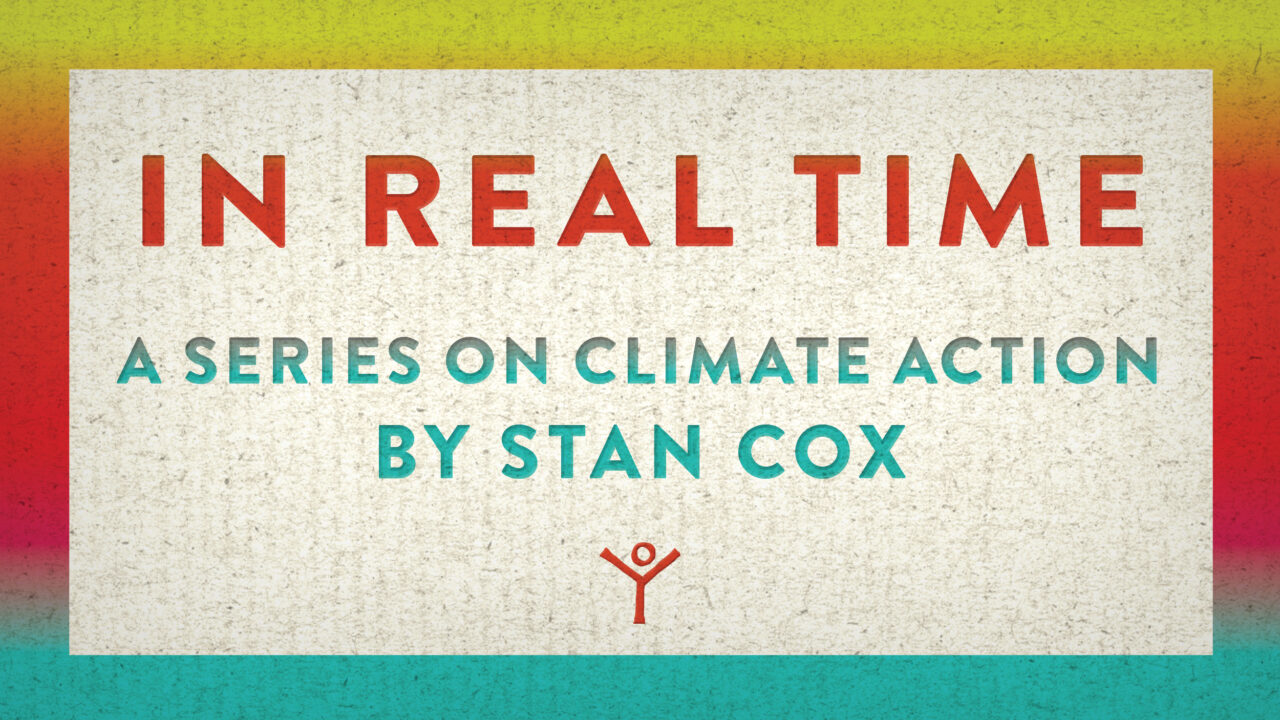By Stan Cox
“In Real Time” is a monthly series on our blog by Stan Cox, author of The Path to a Livable Future and The Green New Deal and Beyond. The series follows the climate, voting rights, and justice movements as they navigate America’s unfolding crisis of democracy.
See an illustrated archive of previous dispatches here. Listen to the “In Real Time” podcast for audio editions of all dispatches, and hear monthly conversations with Stan on the Anti-Empire Project podcast. Also see the evolving “In Real Time” visual work.
Four months into the “In Real Time” project, I see our nation’s condition taking a dramatic turn for the worse. Rising threats of election-year corruption and violence, along with devastating Supreme Court decisions on climate, guns, and abortion have many of us reeling. Movements for human rights, democracy, and the environment are pressing on nonetheless.
The Poor People’s Campaign
On Juneteenth weekend, tens of thousands of people walked up Pennsylvania Avenue toward the U.S. Capitol as part of the epically titled Poor People’s and Low-Wage Workers’ Assembly and Moral March on Washington and to the Polls. (Priti Gulati Cox and I traveled via Amtrak from Kansas to join in.) Although we were following the footsteps of a mob that had stormed the Capitol seventeen months earlier, this march embodied the polar opposite worldview. At the rally ending the march, Poor People’s Campaign co-chair Rev. William J. Barber II made that clear, saying that the event was not a violent insurrection but rather “a resurrection” of people power against violence.
Like its namesake led by Rev. Martin Luther King Jr. in 1968, the Poor People’s Campaign is working to end the violence being inflicted every day by a soulless economic-political system. The night before the march, at a somber, tearful vigil in front of the Lincoln Memorial, marchers gathered to mourn the victims of the past two horrific years, including more than a million Americans dead of COVID-19, along with countless more deaths from poverty, systemic racism, militarism, and ecological degradation. Rev. Barber solemnly declared this tide of death, mostly preventable, to be a case of “policy murder” that must be stopped.
A day earlier, the campaign’s other co-chair, Rev. Liz Theoharis, also decried the violence being inflicted on Americans, telling members of Congress:
Any nation that chooses not to lift 140 million people out of poverty and low incomes, any nation that chooses to disenfranchise voters, to withstand the greatest attack on voting rights since right after the Civil War, any nation that allows the poor to be hurt first and worst by ecological devastation and the denial of health care . . . is issuing a declaration of war on the poor.
The decisions that tumbled out of the Supreme Court soon after Juneteenth also qualify as “policy murder.” By cramping the government’s ability to regulate greenhouse-gas emissions, a six-justice majority set a precedent that will lead to countless more deaths from heat, fire, flood, and storms. By striking down firearms regulations in New York, they hamstrung efforts to stem the tide of gun violence. And by snatching away the half-century-old right to an abortion, they rendered millions of women vulnerable to grievous consequences, from bodily harm to legal jeopardy and more.
These decisions forebode that the Court will likely do further violence by eliminating many other fundamental rights of individuals and striking down regulatory laws crucial to the public’s well-being. The six reactionary justices are immune to the will of the people and can be thwarted only by kicking or keeping their enablers out of Congress at the polls this fall.
The decisions that tumbled out of the Supreme Court soon after Juneteenth qualify as “policy murder.”
“Show Up Armed”
The Poor People’s Campaign aims to mobilize poor and low-income voters from all races, ethnicities, and faiths to defy violence in all of these forms. So it’s doubly dreadful that this fall, voters, as well as election officials, are likely to face a heightened threat of violence at the polls.
Last month, the House January 6 Committee hearings highlighted the abuse now being endured by the people who keep the electoral system going. Perhaps most appalling was the testimony of Georgia election workers Wandrea’ “Shaye” Moss and her mother, Ruby Freeman. When Donald Trump falsely accused them by name of scanning fake ballots in 2020, they were bombarded with death threats, many of them racist. Moss had to change her appearance, go into hiding, and work remotely. She finally left her job in April and is still suffering harassment.
Election workers across the country, fearing for their safety, are resigning in droves. Often, they are being replaced by people who are willing to subvert the vote. A nationwide survey found that one in six election officials has been personally threatened, and one in three knows a fellow official who resigned because of threats.
The election-year metaphor “battleground states” is threatening to turn grimly literal. I was shocked to learn that today only seven states and the District of Columbia ban guns from polling places. With the rise in violent rhetoric and gun violence that’s been occurring since the 2020 election, voting sites and vote-counting centers are bracing for increased violence in November. Officials are worried because of folks like Mike Detmer, a contender for the Michigan state senate in the August 2 Republican primary. He told a meeting of prospective poll workers in January, “The ideal thing is to do this peaceful, that’s ideal, but the American people at some point in time, if we can’t change the tide, need to be prepared to lock and load. So, if you ask what we can do, show up armed.”
As scary as all of this sounds, it’s unlikely that Republicans will try to take power solely through force, though January 6 was an attempt to do exactly that. If we lose elections in 2022 because there are low turnouts on our side, it will more likely be attributable to a collective sense of powerlessness than to a fear of violence. Accordingly, the Poor People’s Campaign has kicked off a nationwide, four-month-long effort to register and energize low-income communities to vote “in historic numbers for our ancestors, for our children, and for the generations to come whose lives and planet are under threat today.”
A big turnout in November 2022 by America’s pro-justice, pro-Earth majority is indeed essential to prevent the nation from drifting further toward fascism. While electoral victories alone can’t resolve our predicament—the past two years have taught us that—they can buy time necessary for a national movement to coalesce and regain the path toward a multiracial, pluralistic democracy. The Poor People’s Campaign could spark such a movement. Almost four hundred “mobilizing partners,” from the mainstream and typically apolitical to the deeply radical, came together for the June 18 rally to address a spectrum of crucial issues. (Priti and I were there with the renowned anti-militarism, pro-human rights group CODEPINK.) It was a great showing, and we should regard the Campaign as a potential movement of movements.

“Expressing Themselves with Two Tons of Metal”
Activists for poor and low-income communities are all too accustomed to the violence that is routinely inflicted by racist and right-wing elements—and, of course, by law enforcement. So, it’s not only election-related violence that must be overcome; nonviolent protest in the public square will increasingly be met with violent backlash from the extreme right and repression from the state.
Approximately 6 percent of respondents to a national poll taken by the Public Religion Research Institute in April 2022 lamented the increasing diversity of America’s population and also agreed with this statement: “Because things have gotten so far off track, true American patriots may have to resort to violence in order to save our country.” Taking the poll’s margin of error into account, the results suggest that this is the position of 10 to 20 million Americans. Some of these people are already demonstrating their willingness to commit violence against nonviolent people whom they consider the enemy. They include the U-Haul truck full of Patriot Front thugs who were apprehended before they could attack a Pride event in Idaho and the lone racist gunman who massacred ten Black shoppers at a supermarket in Buffalo.
Because the June 18 Poor People’s march and rally had a permit, D.C. police completely blocked off a long stretch of Pennsylvania Avenue. Marchers and rally-goers were free to exercise their constitutional rights on a vast open field of hot asphalt. I thought back to May and June of 2018, on the fiftieth anniversary of the original Poor People’s March, when Priti and I had joined the campaign in a couple of rallies and civil disobedience actions in Topeka, Kansas. Actions included blocking traffic at major intersections near the state capitol. The campaign had not obtained a permit, but police swooped in to reroute cars and trucks anyway. Dozens of us lay in the crosswalks for hours until police finally got us up and issued traffic citations. The many drivers whom we inconvenienced were, for the most part, very patient, some even supportive. Only a lone pickup driver got a bit aggressive.
It’s hard to imagine things playing out that way these days. Starting in 2020, when Americans surged into the streets after police killed George Floyd, protesters have been facing much higher risk to life and limb. Last year, an analysis by the Boston Globe found that between May 2020 and September 2021, U.S. motorists slammed into groups of protesters at least 139 times, causing three deaths and at least 100 injuries. The assaults continue. “You’re going to have people coming in and expressing themselves with two tons of metal on wheels,” a transportation security expert told the Globe. “That’s part of the landscape now.”
It’s not only election-related violence that must be overcome; nonviolent protest in the public square will increasingly be met with violent backlash from the extreme right and repression from the state.
Just last month, in Cedar Rapids, Iowa, a man plowed his pickup into several women protesting the Supreme Court’s overturn of the Roe v. Wade decision. He drove over and broke one woman’s ankle. Iowa, like Florida and Oklahoma, passed a law in the wake of the 2020 protests heightening penalties for protesters while immunizing drivers who run into or over protesters—if they claim to have been fleeing in fright. Police did not immediately charge the Cedar Rapids assailant. Meanwhile, police across the country violently attacked groups of people who dared turn out to protest the Court’s abortion decision.
Legal experts worry that the Supreme Court’s strikedown of New York’s gun law will also chill nonviolent protest. When protesters or counter-protesters carry guns, demonstrations are about six times more likely to turn violent. That intimidating prospect discourages turnout. Yet the gun toter at a protest scene, like the vehicle driver, is getting increasingly favorable treatment. The defense team for Kyle Rittenhouse, who killed two men as they were protesting in Kenosha, Wisconsin, in 2020, argued illogically but successfully that he acted in self-defense. Rittenhouse feared, they said, that if he did not shoot the protesters, there was a chance that one of them would snatch his gun away and kill him. This dangerous illogic—that my gun makes you a deadly threat—is often used to protect cops who shoot unarmed people, and now it has been applied to white, right-wing civilian vigilantes as well.
Long Odds Call for Longer Vision
A pro-Earth, pro-democracy, anti-poverty, anti-racist, anti-war transformation was already a long shot well before the rise of MAGA world, and the chief impediments haven’t changed. For climate, it’s the system’s insistence on unlimited economic growth. For Black lives and voting rights, it’s the elected and unelected public officials who continue to benefit from a racist, undemocratic system. For closing the vast economic gap between the few haves and the many have-nots, it’s the haves, with their massive political power.
Today, those obstacles may appear insurmountable. So why do the Poor People’s Campaign and other movements keep pushing against these longest of odds, even as the threat of violent retaliation escalates? Why don’t they just figure out how to adapt to life in an unacceptable system? They press on because long odds don’t equal impossibility. Introducing a must-see gallery of “48 protest photographs that changed the world” in the July 2 Guardian, George Monbiot writes:
Protest is not, as governments like ours seek to portray it, a political luxury. It is the bedrock of democracy. Without it, few of the democratic rights we enjoy would exist: the universal franchise; civil rights; equality before the law; legal same-sex relationships; progressive taxation; fair conditions of employment; public services and a social safety net. . . . And we will continue to come out in defiance, as people have done for centuries, even when facing state violence and repression. Everything we value depends on it.
At a time when rights hard-won in past struggles are being wrested away from us, we can draw strength from the knowledge that if people-power has prevailed in so many such struggles before, it can prevail again.

Stan Cox began his career in the U.S. Department of Agriculture and is now the Lead Scientist at The Land Institute. Cox is the author of The Path to a Livable Future: A New Politics to Fight Climate Change, Racism, and the Next Pandemic, The Green New Deal and Beyond: Ending the Climate Emergency While We Still Can (both with City Lights), Any Way You Slice It: The Past, Present, and Future of Rationing, Losing Our Cool: Uncomfortable Truths About Our Air-Conditioned World (and Finding New Ways to Get Through the Summer) and Sick Planet: Corporate Food and Medicine. His writing about the economic and political roots of the global ecological crisis have appeared in the New York Times, Washington Post, Los Angeles Times, The Nation, Hartford Courant, Atlanta Journal-Constitution, Baltimore Sun, Denver Post, Kansas City Star, Arizona Republic, The New Republic, The Guardian, Al Jazeera, Salon, and Dissent, and in local publications spanning 43 U.S. states. In 2012, The Atlantic named Cox their “Readers’ Choice Brave Thinker” for his critique of air conditioning. He is based in Salina, Kansas.

